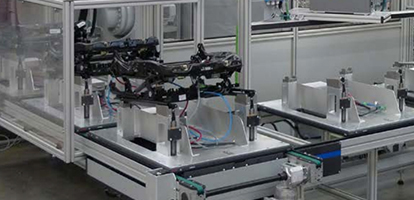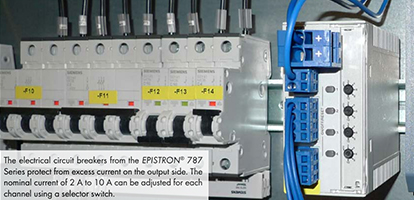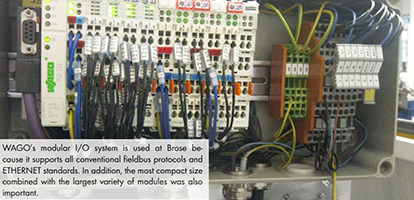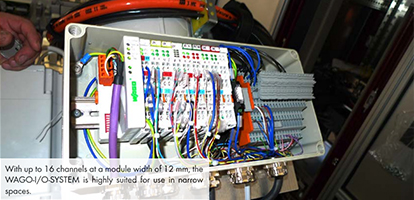




In their production lines, the automotive supplier Brose depends on decentralized automation using robust and reliable components, designed according to IP20. Low installation space requirements, simple and fast expandability, and the ability to integrate different bus systems are the more important challenges here. They use the WAGOI/O-SYSTEM 750 and electronic circuit breakers from the EPISTRON® family.
Brose Fahrzeugteile GmbH & Co. supplies around 80 car manufacturers and more than 30 vendors with systems for vehicle doors, luggage compartment doors, and seating structures, as well as electrical drives. To connect the automation components in the production systems, Brose relies on WAGO’s modular 750 Series I/O system. “We have to integrate systems from multiple manufacturers using various bus systems, and protect the components from the often harsh environmental conditions. There is only a little space left over for the hardware. Therefore, it must be very compact, and despite that, extremely flexible,” Alexander Gran, manager for software development and electrical engineering in drive technologies at Brose, explains the challenges placed on the automation components.
Different Fieldbus Protocols Are Integrated
The ability to integrate different fieldbus protocols from the system manufacturers was an important topic. Industrial robots are typically equipped with DeviceNet, a fieldbus based on CAN. In contrast, other systems can only be controlled using PROFIBUS. WAGO’s modular I/O system is used at Brose because it supports all conventional fieldbus protocols and ETHERNET standards. In addition, the most compact size combined with the largest variety of modules was also important.
“The automation components for our welding systems are implemented in the IP20 protection class. These have to be installed in a completely enclosed control cabinet, which offers very little space for devices and connections. WAGO offers an enormously high packing density, with up to 16 channels on a module width of only 12 mm. This allows us to combine digital and analog inputs in the smallest space. This would not be doable using a conventional IP67 system,” asserts the electrical engineering expert at Brose.
High Variability among the Function Modules
Brose uses a multiplicity of automation components with the most varied of sensors and actuators. This requires a similarly high variety among the function modules. Digital and analog signals are processed using 4, 8, and 16 channels, counter and measurement modules, as well as low-side switching input modules. High innovation cycles with regard to products, and continuous changes to the systems additionally demand a very high degree of flexibility with regard to the connection of the automation components. “The modular I/O system from WAGO can be expanded quickly and easily. We only have to plug in an additional function module to run a new sensor. This has proven to be a great advantage in practice,” according to Alexander Gran.
Electronic Circuit Breakers for Meeting Changing Demands
Brose has used electronic circuit breakers for a long time. WAGO got their chance when a device from the previous supplier failed. “We had to act fast. WAGO created a replacement part for us overnight, which I could take to the construction site in the morning. The replacement worked immediately, and, in addition, the device proved to be more powerful than the previous one,” the Brose technician continues with the history.
In the time before WAGO, different modules were required for different current ranges. Now, one device sufficed. The nominal current in the electronic circuit breakers in the EPISTRON® family can be set in dividually from 2 A up to 10 A using a selection switch. “During expansions of partial variants in our systems, we always had the problem that the warning range was no longer correct. We were forced to exchange the module. The selectivity is now better, and we only have to re-justify the warning range for the same device,” reports Gran. As additional advantages of the technology, he cites the high packing density and the ease of cabling using CAGE CLAMP® connection technology.
WAGO offers electronic circuit breakers whose triggering is superior to protective devices using thermomagnetic characteristic curves. They protect devices from the EPISTRON® 787 Series from excess currents arising on the output side, they react reliably according to exactly defined times with low tolerances. In addition, they are especially well suited for cases in which the consumer is connected via a longer conduit. Due to the constant monitoring of the loop impedance, the device can distinguish between a short circuit and capacitive loading, even at long conductor lengths and low cross sections.
Good Experience with Modular Technology
“The modular technology from WAGO convinced us. It is very robust and functions problem-free. In addition, the Sales and Technical Support have been models of assistance,” Alexander Gran praises his good experiences. As an example, he described initial difficulties with DeviceNet applications. It was very clear in this case that the problem was not with the WAGO technology. In spite of this, the Brose technician emphasizes, the people at WAGO worked intensively to find the error and they were able to jointly find a solution.
Text: Frank Sünkel, WAGO
Photo: Brose